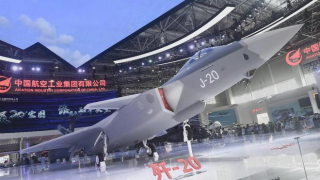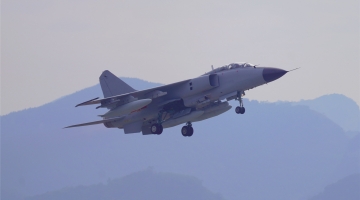
By Li Wei and Meng Lu
李 伟 孟 路
Japan has continued to strengthen the building of offensive combat capabilities through internal military construction and foreign military cooperation recently. Analysts believe that Japan's moves will bring more instability and uncertainties to the regional security situation.
近日,日本通过内部军事建设和对外军事合作“双线并进”,持续强化进攻作战能力建设。分析人士认为,日本上述做法将给地区安全局势带来更多不稳定、不确定因素。
Accelerate the pace of construction internally
对内加快建设步伐
Increase defense budget. The Japanese media Nikkei reported that according to the Japan Ministry of Defense, the total defense expenditure of Japan will reach 48 trillion yen, or about 325 billion dollars, from the fiscal year 2023 to the fiscal year 2027. These funds will be used to achieve the government's five-year goal of strengthening defense capabilities. Japanese Prime Minister Fumio Kishida said that the new defense spending will be mainly used to develop counterattack capabilities such as attacking enemy's missile launch bases, as well as continuous combat capabilities such as long-range missiles and precision-guided munitions.
增加防卫预算。日本经济新闻网报道称,据日本防卫省估算,2023财年至2027财年,日本防卫费总额将达到48万亿日元。这些费用将用于实现5年内加强防卫能力的政府方针。日本首相岸田文雄表示,新增防卫费将主要用于发展打击对方导弹发射基地等“反击能力”,以及远程导弹、精确制导弹药等“持续作战能力”。
Increase the application of technology. Japan's Kyodo News Agency reported that Japan plans to set up a new conference organization where the National Security Strategy and relevant ministries and agencies work together to promote the application of cutting-edge technologies in defense. The Council of Science, Technology and Innovation, which serves as a coordination mechanism for science and technology policy, will also participate in it to create a inter-departmental collaboration system.
加大技术运用。据日本共同社报道,为推动尖端科技应用于防卫领域,日本拟新设国家安全保障局和相关省厅携手合作的会议组织。作为科技政策协调机制的综合科学技术与创新会议也将参与其中,打造跨部门协作体制。
Strengthen network power. According to Japan's Kyodo News Agency, the Japanese Ministry of Defense is coordinating and planning to increase the number of the cyber-defense unit of the Japan Self-Defense Forces (JSDF) established in March 2022 to about 5,000. The Japanese Ministry of Defense plans to increase the number of core personnel dedicated to responding to cyber-attacks to about 890 by the end of 2022, and to 4,000 to 5,000 by 2027.
强化网络力量。据日本共同社报道,日本防卫省正在展开协调,计划将今年3月成立的自卫队“网络防卫队”人数增至约5000人。日本防卫省计划在今年年底前,把专门应对此类网络攻击的核心人员增至约890人,到2027年度增至4000至5000人。
Improve the level of cooperation with foreign countries
对外提升合作水平
Integrate into the NATO cyber warfare system. Japanese Defense Minister Yasukazu Hamada said in early November that Japan has formally joined the NATO Cooperative Cyber Defense Centre of Excellence (CCDCOE). The Japan Ministry of Defense stated that Japan has been sending staff to the CCDCOE since 2019 and has officially participated in the center's Locked Shields cyber defense exercise since 2021. Japan hopes to further strengthen cooperation with NATO member states in the cyber field.
融入北约网战体系。日本防卫大臣浜田靖一11月上旬表示,日本已正式加入北约合作网络防御卓越中心。日本防卫省称,日本自2019年开始向该中心派遣工作人员,并于2021年起正式参加该中心“锁盾”网络防御演习,希望进一步加强与北约成员国在网络领域的合作。
Improves the level of cooperation with the UK. The British Financial Times recently reported that the UK and Japan plan to sign the Reciprocal Access Agreement in December, which will lay the legal foundation for joint exercises and logistic cooperation between the two countries. In addition, the two countries will announce the details of the joint development of new fighter jets in December.
提升与英国合作层次。英国《金融时报》近日报道称,英国与日本拟于12月签署《互惠准入协定》,该协定将为两国联合演习和后勤合作奠定法律基础。此外,两国还将于12月公布联合研制新型战斗机的合作细节。
Strengthen cooperation with the US military. According to the website of NHK, fighter jets of the Japan Air Self-Defense Force (JASDF) and US bombers conducted joint tactical training over the waters surrounding the Kyushu region of Japan on November 5. Five F2 fighter jets of the JASDF, two B1 bombers and two F16 fighter jets of the US Air Force participated in the training.
强化与美军协同作战。据日本广播协会网站消息,11月5日,日本航空自卫队战斗机和美军轰炸机等,在日本九州地区周边海域上空进行联合战术训练。参加联合训练的包括日本航空自卫队5架F-2战斗机,美国空军2架B-1轰炸机和2架F-16战斗机。
Broken windows effect worthy of vigilance
破窗效应值得警惕
It should be said that Japan's recent small strides in the construction of offensive military capabilities are incompatible with its positioning as a "pacifist country" after World War II. In the future, relevant countries need to focus on guarding against the following two tendencies.
应该说,日本近期在进攻性军事能力建设方面“小步快走”,与第二次世界大战后“和平主义国家”的定位格格不入。未来,相关国家需重点防范以下两种倾向。
The first is that allies are looking for opportunities to "open the door." Taking the construction of integrated network combat capabilities as an example, Japan and the ROK will strengthen cooperation with NATO in the grey area of network defense, which will further make NATO's way to Asia and may change NATO's traditional European attributes and make it a military alliance across Eurasia. The US-led NATO may use the gimmicks of strengthening coordinated combat capabilities and improving the security level of allies to help Japan improve its offensive combat capabilities.
一是盟友寻机“登门槛”。以一体化网络作战能力建设为例,日本和韩国在网络防御这一“灰色地带”加强与北约合作,将进一步打开北约通往亚洲的大门,可能改变北约传统的欧洲属性,使其成为一个横跨亚欧大陆的军事联盟。下一步,以美国为首的北约或将以强化协同作战能力、提升盟友安全水平等为噱头,协助日本提升进攻作战能力。
The second is that Japan might take the opportunity to "break the window". The Kishida administration will issue new versions of three major national defense policy documents including the National Security Strategy, National Defense Strategy (the former National Defense Program Guidelines) and the Medium-Term Defense Program at the end of 2022. According to external assessments, the Kishida administration will further exaggerate external security threats in relevant documents, and clearly include content such as a substantial increase in defense expenditures and the development of offensive combat capabilities, thereby further bypassing the Peace Constitution and purely defensive defense policies, and continue to move toward the goal of becoming a military superpower, which will make the security situation in the Asia-Pacific region more complicated.
二是日本借机“破窗”。今年年底,岸田政府将出台新版《国家安全保障战略》《国家防卫战略》(即之前的《防卫计划大纲》)和《中期防卫力整备计划》三大国防政策文件。外界评估认为,岸田政府在相关文件中将进一步渲染外部安全威胁,明确写入大幅提升防卫开支和发展进攻性作战能力等内容,从而进一步架空“和平宪法”和“专守防卫”政策,继续朝着军事大国目标迈进,使亚太地区安全形势更趋复杂。











